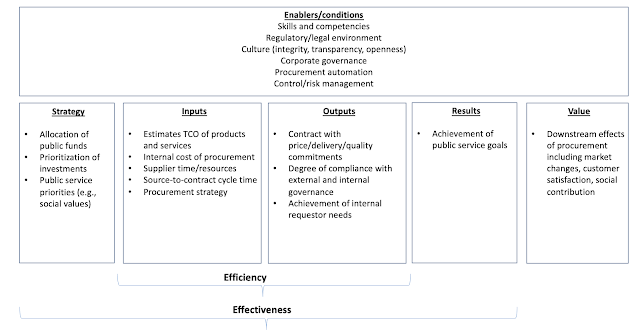The Journey to Value-Based Procurement Process 4.0 [Part 2]
The public procurement process should be about value, not just savings
What matters most when we elect a public servant - a healthy society, clean and secure environment, quality education - or the savings they deliver?
Arguably, we expect the state officials to manage public spending wisely and obtain the highest value to society for the allocated budget.
Essential macroeconomic functions of government
As suggested in this document, there are three primary macroeconomic functions of government:
- allocation function to achieve efficiency,
- redistribution function to achieve equity,
- stabilization function to achieve stability.
Firstly, neither of these functions assumes savings. Those are about spending for the proper purpose, rectifying inequality, and securing economic stability.
Secondly, this definition recalled a vital term - "efficiency" - and omitted another crucial one - "effectiveness."
Efficiency vs. effectiveness
The memorable quote by Peter Drucker tells us that "the efficiency is doing the thing right. Effectiveness is doing the right thing."
A view on procurement management efficiency
Efficiency is operational excellence. It is about keeping your house in order and achieving the most with what's available.
One of the theories of the firm - the theory of dynamic capabilities, which we explained in this post - classified efficiency as an ordinary capability. It is sufficient for survival but not necessary for prosperity.
Most importantly, it is imitable alongside best practices that many of our bosses are so proud of!
The public procurement management efficiency only considers the correlation between inputs (cost estimates, transactional procurement costs, sourcing strategy) and outputs (actual contract conditions, compliance, and fulfillment of a public authority's needs.)
Effectiveness is the dynamic capability.
Meanwhile, the concept of procurement effectiveness is far more complex. It controls how government priorities and a public fund strategy translate into the outcomes of the public service goals, as per the essential model developed by OECD.
Effectiveness classifies as one of the dynamic capabilities, the genuine source of competitive advantage.
Effectiveness is superior capability; it aligns ordinary capabilities to match the requirements and opportunities of the changing business environment.
Measuring the procurement effectiveness by citizen's satisfaction with the public services and thus qualifying the value for money is very challenging.
Therefore, many governments decide to juggle the motto "let's spend less" and reinforce the anachronic low-bid culture.
Procurement management must look for customer experience, not just procurement savings!
Therefore, we suggest conscious citizens judge public companies for their effectiveness. To do that, you may start assessing their service level.
Then you'd realize that the cost of services is only an element of the internal quality, which matters to public companies and other operational metrics.
Meanwhile, citizens evaluate public services by
- process,
- customer services,
- facilities,
- information.
Would you evaluate public services by how much money someone saved to provide you with a suboptimal customer experience?
Examples of brave public procurement processes
This post doesn't mean that procurement should not save public money.
Ideally, it shouldn't be obsessed with saving money upfront before the contract signature.
There's no sense in fighting for fluff savings before the end-product delivery or service launch, as that money has no value.
Then procurement only forces vendors to play with the sides of the iron triangle and sacrifice eventual quality to provide discounts from the revenues they haven't collected yet.
Brave public procurement should incentivize vendors to deliver value share eventual benefits. Possible realizations of this could be
- PPP (Public-Private Partnerships) can be described as any form of cooperation between government institutions and private sector economic operators to ensure the funding, construction, renovation, management, and maintenance of infrastructure (works) and/or the provision of a service. Eventual payments may come from the contracting authority or infrastructure users (e.g., tollgates.)
- Value-based procurement encourages the cooperation between state healthcare institutions and their suppliers to provide measurable benefits to patients over and above the purchase price reduction.
- Outcome-based procurement is the selection of suppliers based on their capability to deliver against defined outcomes (success criteria) and rewarding them in part or whole on the delivery of those outcomes.
- Best-value procurement or MEAT tenders, where the contracting authority takes account of criteria that reflect qualitative, technical, and sustainable aspects of the tender submission and price when reaching an award decision.
Public procurement management may dilute the uninspired low-bid supplier selection and reinforce its ambition to become the strategic value-generating function with these and some more value- or outcome-based sourcing methods.
P.S. If you appreciate hundreds of hours invested in researching and writing this blog, you can buy me a coffee or subscribe for the membership by following this link. Thank you!
More information on this and other exciting topics can be found in "The Technology Procurement Handbook." It represents 23 years of experience, billions of dollars worth of successful sourcing projects, and 1000s of hours spent on research, analysis, and content creation for the most demanding professional readers.






Comments
Post a Comment